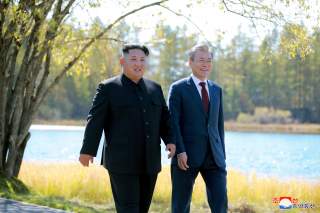The Hanoi Summit – We Asked Leon Sigal What Happens Next in U.S.-North Korea Relations
"The need now is to resume talks, the sooner the better, with the aim of having both sides offer a little more to each other."
Editor’s Note: Looking for more opinions on where we go after the Hanoi summit? Check out all 80 expert takes on where U.S-North Korea relations go next here.
President Donald Trump and North Korean leader Kim Jong-un both overreached at the Hanoi summit, demanding too much and offering too little. Yet each side put enough on the negotiating table for the makings of a deal. The need now is to resume talks, the sooner the better, with the aim of having both sides offer a little more to each other.
The months of meetings between the two sides’ diplomatic and intelligence officials leading up to the summit satisfied some of both countries’ demands. In an October meeting with Secretary of State Pompeo, according to Special Representative for North Korea Stephen Biegun, Kim made an unprecedented offer: “dismantlement and destruction of North Korea’s plutonium and uranium enrichment facilities…and more.” Addressing North Korean desires for an end to enmity—reconciliation—Washington first suspended and then scaled down joint exercises on the Korean Peninsula, offered to negotiate an end-of-war declaration and exchange liaison offices. America also rightly backed off from demanding a complete inventory of the North’s nuclear and missile assets. Instead, Washington sought access to Pyongyang’s plutonium reactors, reprocessing and enrichment sites, as well as its nuclear test sites, uranium mines, ore refining plants, and uranium hexafluoride plant. All of this would let America assess how much fissile material the North could have produced. Since U.S. intelligence estimates vary widely, this nuclear archeology would have reduced uncertainty and headed off premature disagreement over the amounts of material Pyongyang had. However, where Washington came up short was sanctions relief.
While it was willing to offer some of what Pyongyang wanted, Washington still demanded a lot more in return. It wanted the verifiable suspension of all fissile material production with a commitment to dismantle the production sites after taking measurements of production. Trump also sought a halt to production of ballistic missiles that could reach Japan and beyond. On the eve of the summit, U.S. negotiators narrowed their focus to suspending all fissile material production with a written commitment to eventual dismantlement, as Kim told Pompeo. But North Korean negotiators stopped short of that, offering only Yongbyon while seeking excessive sanctions relief in return.
Instead of trading additional sanctions relief for a complete end to fissile material production, Trump “challenged the North Koreans to go bigger.” That understatement by a senior State Department official meant seeking “a complete freeze on their weapons of mass destruction programs,” which seemed to include chemical and biological weapons.
Why swing for the fences when singles and doubles drive in more runs?
Now the task is to pick up the pieces, testing whether relaxing sanctions will yield more than tightening them and making North Korea more dependent on South Korea than on China for a change.
Leon V. Sigal is director of the Northeast Asia Cooperative Security Project at the Social Science Research Council in New York. He wrote Disarming Strangers: Nuclear Diplomacy with North Korea.
Image: Reuters

